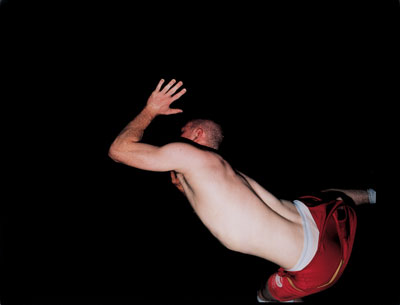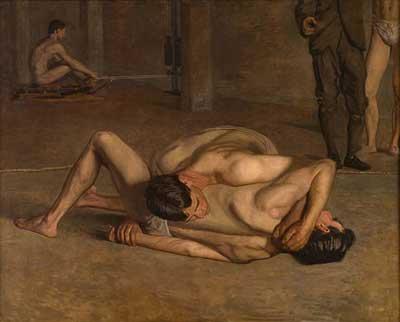Hard Targets—Masculinity and Sport, which opened in October and runs through January 18, has me thinking about how artistry and athleticism have intersected in the past.
To me the unscripted intensity of Shaun El C. Leonardo's Bull in the Ring, which he performed on Hard Targets' opening night, was paradoxically heightened by the precise choreography of the warm-up and drill and its ritualistic aspect, both athletic and artistic. All summer, Leonardo told us, he had been on a "strict nutrition plan and workout program just to be physically and mentally prepared... training and coaching with a team" for the performance. This "dualism," as he calls it, between performance and sculpture, and art and reality, creates an amazing tension—one that is actually very present in a totally different kind of artwork in LACMA's collection: Wrestlers, painted in 1899 by Thomas Eakins.

Thomas Eakins, Wrestlers, 1899, gift of Cecile C. Bartman and The Cecile and Fred Bartman Foundation
Not unlike the aims of the football drill staged in the performance, Wrestlers alludes to what it took to be the best nineteenth-century academic artist, which meant being able to paint the human body masterfully. Artists had to train, practice, and study the body, paralleling the regimen of the male athletes and the coaches looking on whom Eakins depicts. For Wrestlers, Eakins photographed young men practicing at the gym, as another Hard Targets artist, Collier Schorr, does too.

Collier Schorr, Lives of Performers (G.R.), 2003, courtesy of the artist and 303 Gallery, New York, © Collier Schorr
Eakins also made an oil sketch in preparation for the final canvas. Just as Leonardo's practice and Schorr's photographs cannot assure the athletic triumph, Eakins's artistic preparations cannot contain the tense aspects of his final painting. Strange details such as the cropped background figures, the two men fully locked in a wrestling move, and Eakins's desire to render the male anatomy and the athletic ritual so exactingly demonstrate that more than a century later, Eakins's Wrestlers is also a surprisingly hard target.



